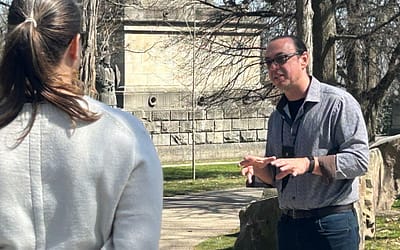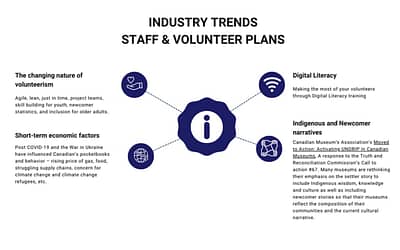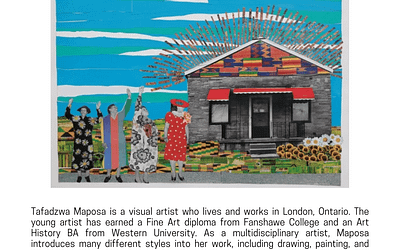Insights
CMA National Conference – April 9-11, 2024
Conference attendees we met agreed that monitoring Indigenous Trends and Revenue Development were crucial success factors for museums today.
Examining Global Practices For Decolonizing Collections
When our team gathered in Toronto in November 2023, we examined leading practices for art and museum workers to apply in our upcoming project and client work.
Environmental Scan – Volunteer Development Action Plan
Please get in touch to arrange a short conversation to get started on responding to your industry, global and community needs and how we can work with you to design your strategic planning requirements over the next couple of years. Schedule your session now at [email protected]
Artist Shoutout – Tafadzwa Maposa
Tafadzwa is an excellent example of the GLAM sector as an artist and an employee of the London Public Library.
Artist Shoutout – Cheryl Ann Hills
After I met Cheryl Ann at an arts festival in Paisley, Ontario, I wanted to highlight her work within my network of colleagues and project partners.
Artist Shoutout – Tracey-Mae Chambers
From September 2023 to February 2024 Ms Chambers was active with our Wiki Wednesday project funded by the Canada Council for the Arts as an Indigenous Advisor. Tracey-Mae was a guest speaker at the February 2024 webinar, available for viewing on YouTube here.
Charting Funding Opportunities
Work with us to explore and map your funding options so you can prioritize the ones that are most likely to succeed for your organization.
Embarking on a Social Enterprise Strategy
Over the last ten years, many organizations have increasingly turned their gaze to examine social enterprise as an additional revenue stream to their conventional tools of membership, fundraising and grant writing.
Linking Strategic Planning to Implementation Strategies for Museums
Using the best digital tools and platforms is key to fostering understanding across departments of core business functions to enhancing visitor experiences as well as increasing revenue and attendance.
Loyalty Loop for Culture
Loyalty Loop for Culture – A smooth loyalty loop involves deliberate decision-making while a sticky journey can be a quick spin.
Wiki Wednesday Series 2 – Digital Literacy for GLAM
This post provides resources, so you can view our data visualizations or knowledge graphs and also follow along with the content by reviewing our Youtube videos.
Wiki-Wednesdays: Wikimedian in Residence and Your Cultural Organization
About the Speaker Jason Evans is a former Wikimedian in Residence at the National Library of Wales, now the National Wikimedian and Open Data Manager. Jason specializes in Wikipedia community outreach, Open Access policy and Linked Open Data with a special interest in...
Orange Shirt Day 2023
About 2 years ago, I published, What should I do on Orange Shirt Day? At the time, I set out to have a day of study and reflection for Canada’s first Orange Shirt Day. I decided to visit the research library of my undergraduate days and then meet a fellow GLAM...
Insights For Creatives and Culture Workers
Going Beyond the Land Acknowledgement Statement Increasingly, over the past couple of years, many Indigenous leaders have recommended that cultural organizations and culture workers should go beyond reading crafted statements, to provide more detailed information by...
Digital Readiness & Innovation In Museums
Baseline National Survey Chris Barr provided leadership for this survey report when he was the Director for Arts and Technology Innovation at the Knight Foundation. The field survey was a partnership with the American Alliance of Museums, capturing data from 480...
Raising the Profile & Discoverability of Metis Artists
Join us for an exciting online event on Wednesday, February 7, 2024 at 12:00 PM EST to celebrate and promote the incredible talents of Metis artists. During this event, you'll be able to explore the diverse art forms and cultural expressions of Metis artists. Learn...
Creating Impactful Online Communities For Older Adults
2020 - Online workshops demonstrated different types of Seniors groups linking arts and technology There are six different types of online communities, including: Knowledge and learning communities Expert networks and advisory communities Event communities Membership...
Downtown Revitalization – Business Action Plan
Our results – an action plan created with community stakeholders, reflective of global and industry trends, yet grounded in unique circumstances.
LOD Projects In Libraries
Over the past year, I have been looking for good case studies or examples of local libraries working with University Librarians and the GLAM sector (Galleries, Libraries, Archives, and Museums). I found out about the Toronto Public Library’s (TPL) involvement...
Artist Shoutout – Quinn Hopkins
Quinn bridges the large territory between his Anishnaabe roots and modern digital art in his work.



















